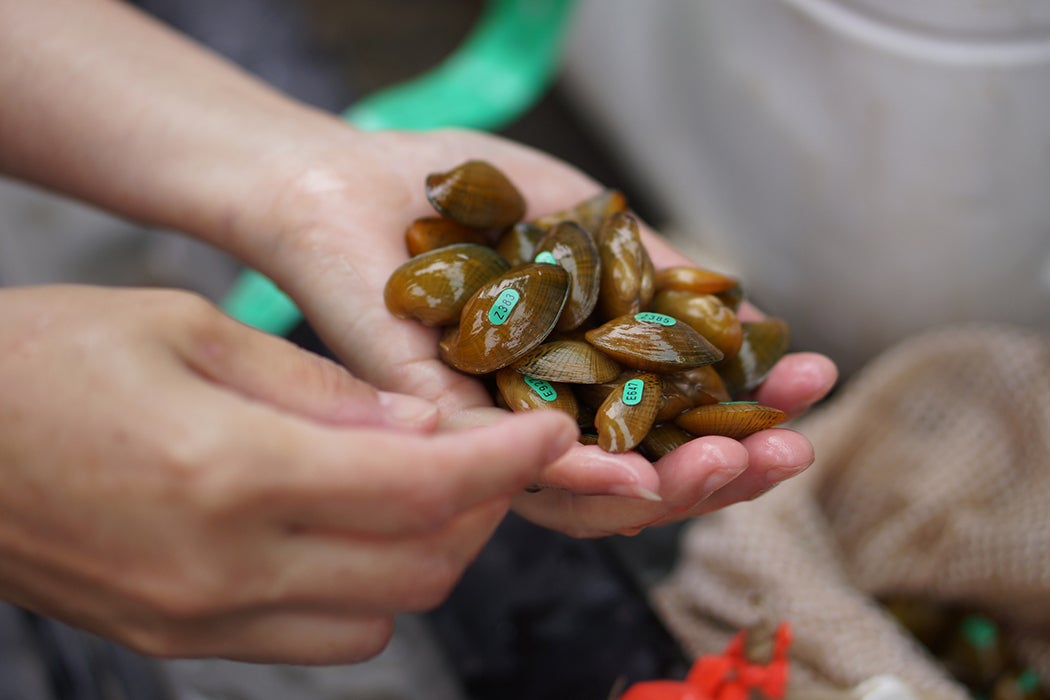Ah, the clambake! It’s a fine old New England tradition of cooking lobsters, crabs, clams, mussels, and even vegetables in a hole in the sand. Cooking seafood underground with hot rocks and insulating seaweed is something Europeans learned from the original inhabitants of these shores. On both the Atlantic and Pacific coasts, Native Americans cooked bivalves in underground pits. Perhaps more surprisingly, plenty of bivalves were eaten in the middle of the continent, too. Only in this case, the seafood was actually river food: freshwater mussels.
North America has some of the greatest diversity of freshwater mussel species, but not many people seem to know about them any more. Some three hundred species have been recorded, with such descriptive names as Snuffbox, Pigtoe, Wartyback, Pistolgrip, Catspaw, Pockebook, Heelsplitter, Mucket, Hickorynut, Spectaclecase, Pimpleback, Rainbow, and Lilliput.
These mussels, in the Unionoida order, have an interesting life cycle for something that sits in the mud for up to 70 years. The larvae, called glochidia, attach themselves to fish gills and fins and disperse as aquatic hitchhikers. But the USGS has called the Unionoida America’s most endangered species: some 70% of the species are already extinct or imperiled.
As Paul W. Parmalee and Walter E. Klippel reveal in their classic analysis of freshwater mussels as Native American food source, whole unused clambakes have been uncovered under layers of clay used to cap the bivalves. Parmalee and Klippel found that 39 species were being eaten by Native Americans from the Early Archaic (c. 10,000 years ago) period up to post-Columbian contact. They write, “Peoples once occupying the regions comprising the Mississippi River drainage exploited this food resource so extensively that the remaining components of many of their camps and villages consist of a preponderance of mussel valves.”
But, Parmalee and Klippel argue, the low caloric bivalves were supplemental food sources, not staples, among the broad range of animals and plants eaten in the rich Mississippi Valley lands. Native American also used the shells as tools and for ornamental purposes, but not in the devastating industrial quantities seen later.
The mussels are a fine indicator of water quality; in fact, as filter feeders, they help make water quality. But pollution, dams, and overharvesting have all taken their toll. From the nineteenth century, the nacreous shells were indiscriminately harvested for mother-of-pearl buttons. This very profitably inland fishery peaked in 1922, and then began a spectacular decline after 1930 due to overexploitation. (Plastic buttons became the industry norm after World War II.)
Then in the 1960s, the Japanese cultured pearl industry started importing American freshwater mussel shells to seed pearls. In this process, rounded pieces of mussel shell, called nuclei, are implanted in oysters. The oysters then coat these nuclei in layers of nacre. Some 90% of the weight of a cultured pearl is actually American freshwater mussel shell. A ton of mussel shells, however, only produce about 60 pounds of these nuclei.
For all the piles of shells in Native American middens, it turns out that industrial fashion has been largely responsible for reducing this incredible natural richness to its imperiled state today.







